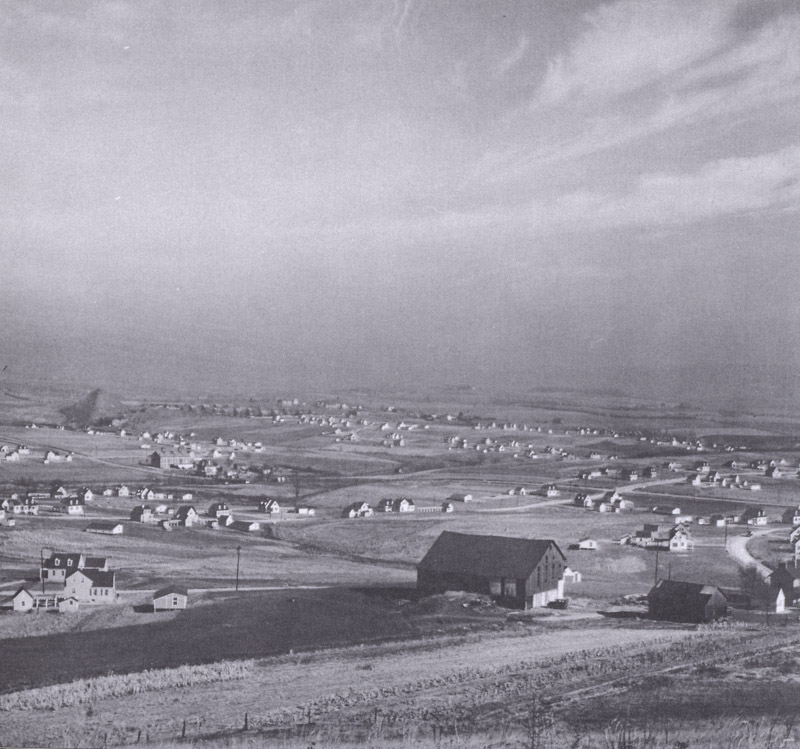
Map of Norvelt, c. 1959 (click on image for a full-size view)
|
Norvelt, in Westmoreland County, is the site of Pennsylvania's first subsistence
homestead. |
| This homestead, originally known as Westmoreland Homesteads, sought to
address the needs of unemployed bituminous coal miners and their families. It was one
of the homesteads designed by the Division of Subsistence Homesteads for "stranded
industrial" workers to "help them build new lives." | 
Westmoreland Homesteads, 1936
(click on image for a full-size view)
|

A Typical Six Room House, Norvelt, Pa.
(click on image for a full-size view)
|
Work began on the site in 1933 and, by 1937, 254 homes had been constructed.
Government administrators and homesteaders worked together to develop Norvelt's
community life. |

Floorplan of a Six-Room Type House, Norvelt, Pa.
(click on image for a full-size view)
|
|
A cooperative farm, store, and garment factory were developed. In
addition, twenty-three social and community groups were organized in Norvelt. Today, a
number of original houses remain and Norvelt has been integrated into the surrounding
area. |
 Plowing the Fields of the Cooperative Farm, Norvelt, Pa.
Plowing the Fields of the Cooperative Farm, Norvelt, Pa.
(click on image for a full-size view) |

Map of Penn-Craft, Pa., c. 1959
(click on image for a full-size view) |
Penn-Craft, in Fayette County, Pennsylvania, was the state's second subsistence
homestead. While it was modeled partly on the government program, Penn-Craft was
administered by the American Friends Service Committee. This Quaker Group,
headquartered in Philadelphia, had extensive relief experience in mining communities.
Several AFSC officers had actually been employed in the federal Subsistence Homestead
Program. |

Temporary Housing, Penn-Craft, Pa.
(click on image for a full-size view) |
So that community life could begin while houses were still under construction,
Penn-Craft settlers built temporary wooden homes that could later be converted into chicken coops. |

Construction of a Stone House, Penn-Craft, Pa.
(click on image for a full-size view) |
| The Friends strove to ensure ethnic and racial diversity, a high-degree of self-help, and a
strong sense of democracy in the new community. Like Norvelt's homesteaders, the
people of Penn-Craft soon began a cooperative farm, store and garment factory.
Penn-Craft was founded in 1937 and still retains a strong sense of community, no doubt a by-
product of the continued presence of original homesteaders and their children.
|

The settlers experimented with angora rabbits as a possible source of wool for the knitting mill at
Penn-Craft.
(click on image for a full-size view) |
The Southwestern Pennsylvania Heritage Preservation Commission was created by
federal law in 1988 under the Department of the Interior. This Commission was charged
with identifying, preserving and interpreting America's industrial heritage in
southwestern Pennsylvania. Through partnerships developed between federal, state, and
local governments, the business community, organizations and private individuals, the
Commission has engaged the southwestern Pennsylvania region in the preservation of its
heritage.
As part of its work, the Commission has conducted surveys of significant industrial,
engineering, historic and cultural resources in southwestern PA. One such survey
undertaken by the Historical American Buildings Survey / Historic American
Engineering Record (HABS/HAER) compares and contrasts the two subsistence
communities of Penn-Craft and Norvelt. This survey, from which this exhibit was created,
is housed in the Special Collections Department at IUP in MG 74.
The results of this and other inventories have been published by HABS/HAER through the Commission, and
are available to the public (a complete set of these publications can be found in
IUP Special Collections MG 75). The
measured drawings and the large-format photographs produced during this process have been
deposited in the Prints and Photographs Division of the Library of Congress in Washington, D.C.
The remaining research material has been retained at IUP. This material includes the 35mm
photographs taken by the HABS/HAER teams, some research notes and correspondence associated
with the project, and maps and blueprints of regional sites and buildings.
*** A searchable database of HABS/HAER photographs is available at the HABS/HAER web site.
| Main | General Info | Hours | Contact Us | Articles and Exhibits
|
| Manuscripts | University History |
URL=http://libs0400.acadlib.iup.edu/depts/speccol/exhibits/norvelt.html
Filename: norvelt.html
Maintained by Phillip Zorich.
Created by Karen Wood.
Last modified: July 15, 2001.
Comments on this site and its contents are welcome; contact the webmaster.








